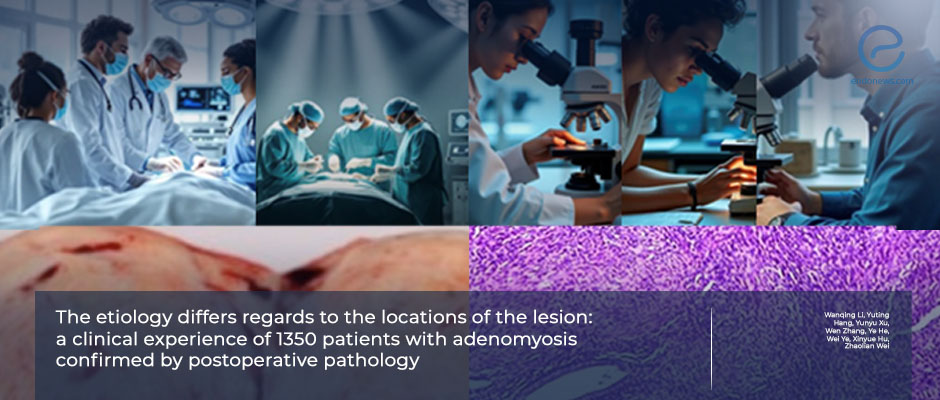Demystifying Adenomyosis: The Role of Anatomic Categorization
Jul 30, 2025
Largest Histologic Review to Date Reveals Anatomical Patterns in Adenomyosis
Key Points
Highlights:
- Adenomyosis is common but remains clinically under-characterized, with unclear associations to endometriosis and varied presentations across patients.
- Anatomical localization of adenomyosis—particularly posterior wall involvement—has been linked to higher surgical complexity and concurrent endometriosis.
Importance:
- Phenotypic heterogeneity in adenomyosis complicates diagnosis and individualized treatment.
- Improved understanding of adenomyosis subtypes (diffuse vs. focal; anterior vs. posterior) can help guide patient-specific management—whether surgical or medical.
- Posterior adenomyosis, in particular, may serve as a red flag for concurrent endometriosis and should inform preoperative planning.
What's done here:
- A large-scale retrospective analysis of 1,350 hysterectomy specimens with histopathologically confirmed adenomyosis was performed.
- Researchers evaluated the topographic distribution (anterior vs. posterior), histologic type (diffuse vs. focal), and clinical correlations of adenomyosis.
- Concurrent gynecological pathologies, including endometriosis and leiomyomas, were recorded and analyzed.
Key features:
- Anatomical classification enabled prediction of concurrent pathologies and informed potential therapeutic pathways:
- Posterior adenomyosis was significantly associated with a 3.24-fold increased risk of coexisting endometriosis, and greater surgical complexity, reflected in increased operating time and larger uterine volume.
- Diffuse adenomyosis correlated with older age, higher parity, and more severe dysmenorrhea; and more frequent co-occurrence with uterine fibroids.
- Focal adenomyosis tended to be diagnosed in younger patients and was less often associated with endometriosis.
Limitations:
- Retrospective design limited the availability of standardized preoperative imaging data and symptom scoring. Clinical symptom data was incomplete or non-uniformly recorded across the cohort.
From the Editor-in-Chief – EndoNews
"This large-scale retrospective analysis brings welcome clarity to the complex clinical landscape of adenomyosis.
By categorizing disease based on both anatomical location and morphologic distribution, the authors offer a practical framework that connects sonographic features with surgical outcomes and symptom severity. Particularly striking is the association between posterior adenomyosis and endometriosis, as well as the distinct profile of diffuse disease in older, multiparous women with severe dysmenorrhea.
These findings underscore the need for subtype-driven clinical management and call for a shift from one-size-fits-all approaches toward personalized, imaging-guided treatment pathways. This work not only refines our understanding of adenomyosis but also lays groundwork for future prospective studies and standardized classification systems."
Lay Summary
Adenomyosis is a common gynecological condition in which tissue similar to the endometrium grows within the muscular wall of the uterus. This can lead to a range of symptoms, including painful periods (dysmenorrhea), heavy menstrual bleeding (menorrhagia), anemia, infertility, and complications during pregnancy.
However, due to its varied presentations and unclear pathobiology, adenomyosis remains challenging to diagnose and treat effectively.
In a large-scale study recently published in BMC Women’s Health, researchers from Anhui Medical University in China analyzed 1,350 cases of surgically treated and histologically confirmed adenomyosis over a six-year period. Each case was categorized by anatomical location (anterior vs. posterior uterine wall) and by disease distribution (focal vs. diffuse), based on ultrasound findings and pathology reports.
Among the patients, 79.6% showed definitive sonographic signs of adenomyosis. Of these, 69.4% had diffuse disease, while 30.6% presented with focal lesions.
Statistical analysis revealed that diffuse adenomyosis was more common in older women with higher numbers of pregnancies and a longer disease duration. It was also strongly associated with dysmenorrhea.
Meanwhile, posterior wall adenomyosis was more frequently linked to coexisting endometriosis, more severe pain symptoms, and increased intraoperative bleeding.
The researchers concluded that combining anatomical (anterior vs. posterior) and morphological (focal vs. diffuse) classifications provides a more meaningful framework for understanding adenomyosis. This approach may allow clinicians to tailor treatment strategies more precisely based on disease subtype.
Research Source: https://pubmed.ncbi.nlm.nih.gov/40448071/
endometriosis histopathology adenomyosis ultrasonography

